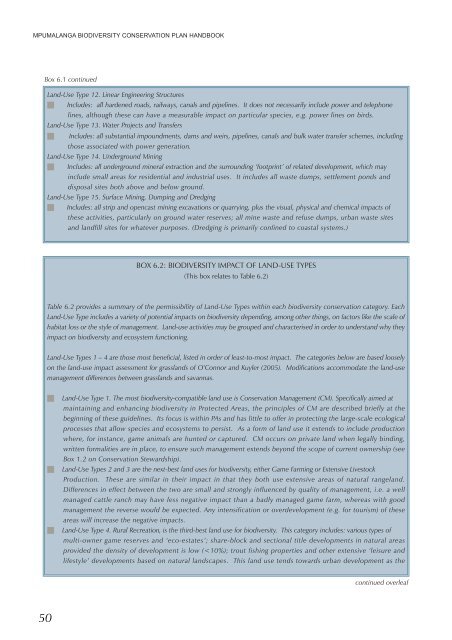Mpumalanga Biodiversity Conservation Plan Handbook - bgis-sanbi
Mpumalanga Biodiversity Conservation Plan Handbook - bgis-sanbi
Mpumalanga Biodiversity Conservation Plan Handbook - bgis-sanbi
You also want an ePaper? Increase the reach of your titles
YUMPU automatically turns print PDFs into web optimized ePapers that Google loves.
MPUMALANGA BIODIVERSITY CONSERVATION PLAN HANDBOOK<br />
Box 6.1 continued<br />
50<br />
Land-Use Type 12. Linear Engineering Structures<br />
Includes: all hardened roads, railways, canals and pipelines. It does not necessarily include power and telephone<br />
lines, although these can have a measurable impact on particular species, e.g. power lines on birds.<br />
Land-Use Type 13. Water Projects and Transfers<br />
Includes: all substantial impoundments, dams and weirs, pipelines, canals and bulk water transfer schemes, including<br />
those associated with power generation.<br />
Land-Use Type 14. Underground Mining<br />
Includes: all underground mineral extraction and the surrounding ‘footprint’ of related development, which may<br />
include small areas for residential and industrial uses. It includes all waste dumps, settlement ponds and<br />
disposal sites both above and below ground.<br />
Land-Use Type 15. Surface Mining, Dumping and Dredging<br />
Includes: all strip and opencast mining excavations or quarrying, plus the visual, physical and chemical impacts of<br />
these activities, particularly on ground water reserves; all mine waste and refuse dumps, urban waste sites<br />
and landfill sites for whatever purposes. (Dredging is primarily confined to coastal systems.)<br />
BOX 6.2: BIODIVERSITY IMPACT OF LAND-USE TYPES<br />
(This box relates to Table 6.2)<br />
Table 6.2 provides a summary of the permissibility of Land-Use Types within each biodiversity conservation category. Each<br />
Land-Use Type includes a variety of potential impacts on biodiversity depending, among other things, on factors like the scale of<br />
habitat loss or the style of management. Land-use activities may be grouped and characterised in order to understand why they<br />
impact on biodiversity and ecosystem functioning.<br />
Land-Use Types 1 – 4 are those most beneficial, listed in order of least-to-most impact. The categories below are based loosely<br />
on the land-use impact assessment for grasslands of O’Connor and Kuyler (2005). Modifications accommodate the land-use<br />
management differences between grasslands and savannas.<br />
Land-Use Type 1. The most biodiversity-compatible land use is <strong>Conservation</strong> Management (CM). Specifically aimed at<br />
maintaining and enhancing biodiversity in Protected Areas, the principles of CM are described briefly at the<br />
beginning of these guidelines. Its focus is within PAs and has little to offer in protecting the large-scale ecological<br />
processes that allow species and ecosystems to persist. As a form of land use it extends to include production<br />
where, for instance, game animals are hunted or captured. CM occurs on private land when legally binding,<br />
written formalities are in place, to ensure such management extends beyond the scope of current ownership (see<br />
Box 1.2 on <strong>Conservation</strong> Stewardship).<br />
Land-Use Types 2 and 3 are the next-best land uses for biodiversity, either Game Farming or Extensive Livestock<br />
Production. These are similar in their impact in that they both use extensive areas of natural rangeland.<br />
Differences in effect between the two are small and strongly influenced by quality of management, i.e. a well<br />
managed cattle ranch may have less negative impact than a badly managed game farm, whereas with good<br />
management the reverse would be expected. Any intensification or overdevelopment (e.g. for tourism) of these<br />
areas will increase the negative impacts.<br />
Land-Use Type 4. Rural Recreation, is the third-best land use for biodiversity. This category includes: various types of<br />
multi-owner game reserves and ‘eco-estates’; share-block and sectional title developments in natural areas<br />
provided the density of development is low (

















